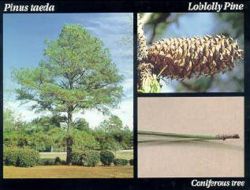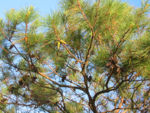Loblolly pine
| Loblolly pine |
|---|

|
| Scientific Classification |
|
| Binomial Name |
|
Pinus taeda |
The Loblolly Pine, or Pinus taeda, is a pine tree that is native to the southeastern United States. God created the Loblolly Pine on the 3rd day of creation along with dry land and the rest of the plants. Originally, most types of Pinus taeda were only in the lowlands. After Europeans disturbed the natural vegetation after settlement, the species was spread to fine-textured, upland, fallow soils. In the Southeast, P. taeda is commonly used in plantation forestry. The loblolly pine regularly forms hybrids with both P. echinata and P. palustris. This pine is also a valuable pulpwood and timber species. [1]
Anatomy
Loblolly Pines often are a height of 100-115 ft (30-35 m) and have a diameter of 1.5-5 ft(0.4-1.5 m). The largest of the southern pines are the extraordinary specimens that can reach up to 150 ft(45 m) tall. It has a bundle of three needles that are sometimes twisted. These can measure 5-9 inches(12-22 cm) long, which is a normal length for southern pines. Southern pines are shorter than Slash Pine or Longleaf Pine, but they are longer than those in the Short leaf Pine and Spruce Pine groups. Their cones are green, and ripen turning a pale buff-brown. They are 3-5 inches(7-13 cm) in length, and 0.8-1.2inches(2-3 cm) wide when closed, and will open to 1.5-2.5 inches(4-6 cm) thick, with each of the scales having a sharp 3-6 mm spine. [2]
Reproduction
Loblolly Pines have buds that are1-2cm. They also have cylindrical pollen cones about 20-40mm that are yellow-brown. The seed cones of loblolly pines mature in 2 years. The shedding seeds soon after the pines mature.[3]
Loblolly pines growth rate is quite rapid, and as a result, along with fire control, they have come to dominate environments that used to be more populated with more longleaf pines or slash pines. The male cones are smaller and only last a short period of time and fall after shedding their pollen. Female cones, however, have many spiraled scales with seeds on each scale. Once mature, the cones open and release the seeds to grow new trees. [4]
Ecology
Loblolly Pine grows mainly in the deep south, and also ranges north, along the mid-Atlantic coast to southern New Jersey, in the inner north to eastern Tennessee, and even as far west as central Texas and Oklahoma. The picture at the top shows an ideal habitat that a loblolly pine might grow in.
These pines are of the "Lost Pines" area around Bastrop, Texas and in McKinney Roughs down the Texas Colorado River. These populations are isolated on areas of acidic sandy soil, and are surrounded by alkaline clays, which are poor for pine growth. [5]
History
Loblolly is defined as a low wet place. Loblolly pines, however, are not limited to only that particular environment. Some common names also used include: Bull Pine, due to its size (quite a few other yellow pines are also frequently named this, particularly large remote specimens); Oldfield Pine, due to loblolly's standing as an early colonizer of abandoned fields; and also Rosemary Pine, because its unique scent compared to the other southern pines. [6]
 Browse |
Related References
- Loblolly Pine From Wikipedia, the free encyclopedia
- Pinus taeda Flora of North America
- Pine From Wikipedia, the free encyclopedia


